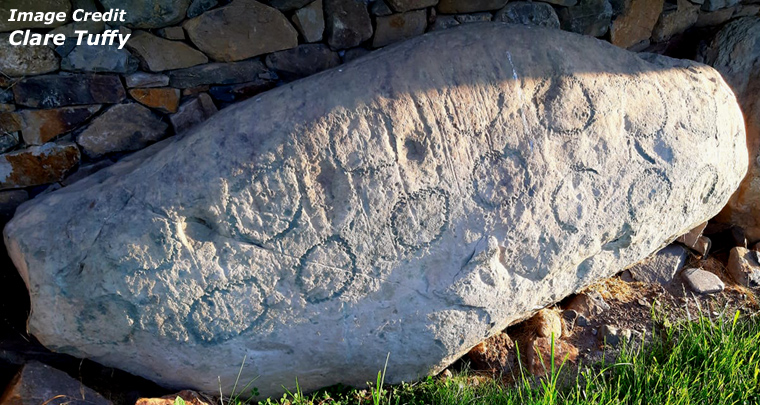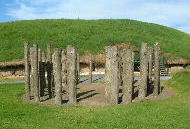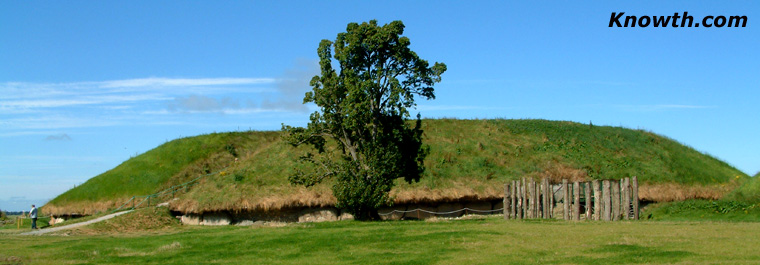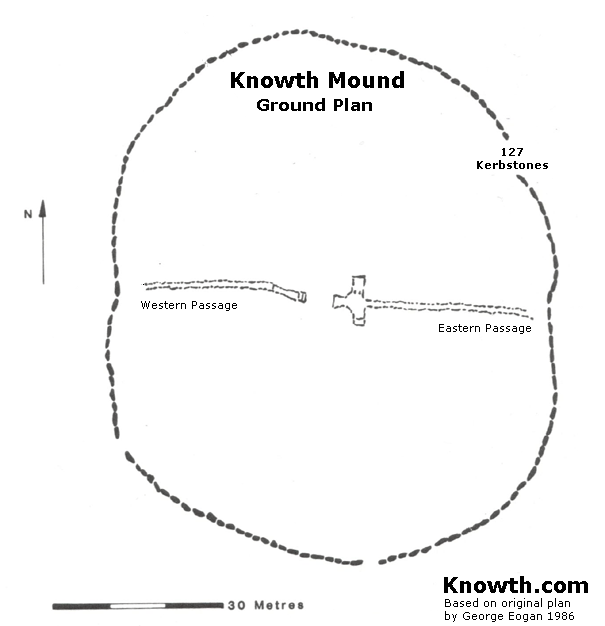Spirals within Spirals, Stones have Stories to Tell
A personal essay by James Nemec (1953-2011) - Page 5
Knowth Kerbstone K42
We moved on, I glanced at another stone. She didn't bother to comment on this stone. There were no spirals or lines carved on it, only discreet sets of circles. I thought of those who had carved it. Were those circles carved by one person or by many? They seemed pretty much the same circles. Maybe it was one person. If so, what was that person like? I reflected upon music again. For me, even plastic art is not so much about the design, composition, or shape, however delightful and pleasant these might be, it was about the feeling coming from the work of art itself. In music, there is a transmission of feeling to the listener. In the plastic arts, there is a transmission of feeling to the beholder.
What was this feeling from this stone with circles? Who would ever know? The tour guide kept moving us forward. I shrugged my shoulders. Leave it to the authorities, I thought. But there didn't seem to be any authorities around, and no one seemed to have really gotten what this place was about. With this insight, I felt giddy with excitement. It was time to explore. I would do this the same way I would work with a client, or with the dolphins in the Bahamas. I would remain as alert, attentive and as open to what would arise as I could. I would have no judgment on what I might experience at this ancient site. I trundled on, keeping up the rear.
I noticed spiral after spiral, seemingly a main motif. Just the spirals, to a mind of an earlier age filled with folklore, could possibly look like snakes. Saint Patrick might have driven the Celts out, but he did not drive out these spirals! For what were the "snakes" but these spiral designs in the rocks that the early Christians did not understand? Who grokked them? Who could get what these designs were, not to mention the zigzags, circles, then or now? I again considered what Eileen had said. There are no literal snakes in Ireland. In any event, Ireland is not known for them.
I lifted my eyes to see a group of stones that would soon provide our entrance into the Knowth mound. How long it would it be before we could go inside? My thoughts of Saint Patrick and spirals morphed in my imagination into the recent book 'Touch the Ocean: The Power of Our Collective Emotions'. As I mentioned before, the book shows how this core physiological system, called the craniosacral system, can release and "unwind" even in a spiral fashion. It is the craniosacral system itself that unwinds, much like a full garden hose that has been crimped and suddenly releases. To use an image from the great-grandfather of craniosacral, Dr. William Garner Sutherland, an unwind is much like a 20th century watchband that has become too tight and suddenly releases, lets go, unwinds
Recall, I had been doing craniosacral therapy for some years with clients in the ocean, and with dolphins in Port Lucaya, near Freeport, in the Bahamas. Not long before writing the book, I observed that when the craniosacral system would let go and open in the ocean, it would tend to move the client's body in the shape of a spiral. I'd hoped then that I wasn't the only craniosacral practitioner who had observed this at the time. But many others did know that the human body could accumulate tensions and blockages over time that are not good for it. This energy can then become frozen in the tissues, sometimes as "tissue memories." When given a chance, the body in its wisdom can recognize these as blockages, and in doing so, allow this held or frozen energy to thaw and release and unwind. The body doesn't always move in a spiral as it throws this old, frozen energy off, but it can, and so the image of the spiral was key for me even before coming to Knowth.
Spiraling impressions continued to run through me. I told myself I was taking this tour much too seriously. I needed to relax and just enjoy myself. After all, I was in Ireland!
We walked around the remains of a small mound to the left, which we briefly examined. Then we walked toward a set of upright wooden pillars. They looked like a group of telephone poles. Our guide told us that no one knew what these pillars were for, or from what era, but that they had been reconstructed here from the "post-hole" remains at the base. She was not at all clear on her facts here. Or I wasn't listening to her. The postholes under the pillars were placed either in 3500 BC, 3 to 5 hundred years before the ancients ever built this place, or they were placed much later around 2800 BC. All I knew was that I got a bad feeling from them. I couldn't get why, exactly.
Was it mere thought association? This was wood and not stone. These wooden pillars looked intrusive in this place. Not to mention the horrific images of torture by pillory from history, Joan of Arc burned at the stake. I tried to discount my feelings as absurd. I tried to make a joke of it to myself, "just telephone poles."
But where did this darker feeling of energy come from now? The Christians? The Normans? And how could I presume to know? Well, I couldn't know, could I? This didn't stop my flood of feelings. Could this dark feeling have come from the time when the Celts were expanding in military might? Or did it originate from a time even before the building of Knowth? This was all very subjective. I thought of the movie, Patton, and General S. George Patton inspecting the battlefields of his past.
I slipped past the others to walk among the pillars myself. Was I still too much in my head? Then I got more of a bad feeling. It was curious because I got this bad feeling only in this one physical location at Knowth. Again, it was just energy, I told myself. But it wasn't at all the clean, clear energy of the original builders. It felt like it had been magic, in the worst sense of the word, magic gone awry. It felt more like it came from the Celts, but again, how could it have been the nice Celts? The Celts loved the Earth and they were peaceful…or something. Maybe it was from the Normans, but the Normans were too recent in the history here. The postholes were older in the history than the Normans, and so was the feeling.
The other tourists didn't seem to be bothered. The elderly man in the Irish Rover hat yawned and smiled to his wife. It was just another stop on the tour.
I didn't have a cellphone or I-phone or Blackberry for immediate access to go online and fact check, but perhaps this was for the best? I had nothing to place between myself and the direct experience of the place. My imagination started to work again. I wondered if the Celts were the same as the Druids? Like most tourists, I would often confuse the Celts with the Druids, and the Druids with the Celts, and had forgotten the Druids came later in history and were associated with the monument of Stonehenge in England. I'd noted at the Visitor's Centre that Knowth was built 1,000 years before Stonehenge. The earliest beginnings of Stonehenge were around 2,500 BC. The Druids were not the same as the Celts, I reminded myself with some relief. Or were they? I couldn't shake this feeling. I could wish I'd taken a camera along with a Wikipedia function. The thought of the Druids and their later generation practices of ritual magic unsettled me.
Who had screwed up? I wondered.
I noticed that Eileen had backed away from the pillars at this point to lie down in the grass and look at the sun. Maybe she had felt it too? My intuitive sense was that the Elder, original Celts here had wisdom. I couldn't know why. Or perhaps it was the earlier, Beaker people, who had carried the wisdom, for they were closet to the ancients in the history of Knowth.
It seemed to have something to do with the wrong kind of worship, worship gone bad.
Now, as I let the impressions spiral, somebody's descendants forgot the lessons of their Elders and this somebody turned something, say, the mounds, into a religion, a bad religion which clouded the expression and the intention of the original builders. Perhaps with the worship of the mounds as external objects, this later group was then scattered to the winds by corruption. By corruption, I mean a corruption of the awareness -- the very awareness that Newgrange was built to keep us mindful of. If the Celts, or the Celtic Druids, or whoever, had kept to the ways of their wise first Elders, I reflected, and to the fine-tuned, sharpened intent of the original builders before them, then they too would have continued to carry the ancient light of wisdom and understanding. I smiled to myself. And old Saint Patrick might never have been able to drive the Celts out of here! Or the snakes out of Ireland!
What if it happened long before Knowth was made?
Something had gone very wrong here, who knew what or when? Our tour guide had no answers. I remained keenly attuned to the land that was surrounding me, teasing out the stories I was hearing from our guide. Was this dark event a spur to inspire the original builders to the creation of Knowth, of Newgrange? No one that day seemed to know exactly when the postholes were built. I was on my own. I continued to the check out the flows and impressions arising within for myself. If one is to be sincere, true and not false, one must check everything out for oneself in one's own experience, otherwise, live a life that is someone else's, a life second-hand. To do this requires trust in one's own reserves of intelligence, strength, and often, information in the form of a higher order of teaching from someone older and wiser to learn how to learn to do this well.
Who knew?
 Later,
I asked my friend why she departed the tour to lie in the grass. What she said disturbed me.
Her feeling was that people had been burned and beheaded in the place of the pillars.
She felt a sense of blood everywhere. Did she think it was the later Celts? I asked her.
She wasn't so sure about that. She said, honestly, she didn't know who it was. Nevertheless,
her sense remained that the cleanest energy here was from the original builders and that
it was still very alive, available, present.
Later,
I asked my friend why she departed the tour to lie in the grass. What she said disturbed me.
Her feeling was that people had been burned and beheaded in the place of the pillars.
She felt a sense of blood everywhere. Did she think it was the later Celts? I asked her.
She wasn't so sure about that. She said, honestly, she didn't know who it was. Nevertheless,
her sense remained that the cleanest energy here was from the original builders and that
it was still very alive, available, present.
Here, in this tainted part of the place, this place of the pillars, I again got a sense of the urgency at work for the original builders of Newgrange, Knowth, Dowth. Again, it seemed that Newgrange was a symbol built to remind us to observe, moment by moment. Knowth, I now began to suspect, a symbol built by the ancients for us to remember to remember. Letting my mind run without censure, whenever these postholes were placed, or by whom, it seemed the ancients knew things could go very wrong. If nothing else, the postholes, or at least the image of the wooden pillars, created a contrast of shapes, if you will. Now, it seemed my friend and I had been in the presence of some kind of ancient teaching. What was that teaching? Was it all around us? It couldn't be seen by seeing it. It couldn't be known by knowing it. It couldn't be forced to perform on command. Whatever our tour guide might be saying, and without knowing it, I was soon to encounter events on the order of the mystical. Would it be an integral experience on the level of Bucke's cosmic consciousness? If only one taste?
Well, here I am! I said to myself, and smiled. What can I learn today?
"Keep up, keep up!" shouted the guide. "Now, we will go inside the mound." I took one look back to find Eileen, but I couldn't see her anywhere. I fell in behind the line of tourists and flashing cameras.
Boyne Valley Private Day Tour
 Immerse yourself in the rich heritage and culture of the Boyne Valley with our full-day private tours.
Visit Newgrange World Heritage site, explore the Hill of Slane, where Saint Patrick famously lit the Paschal fire.
Discover the Hill of Tara, the ancient seat of power for the High Kings of Ireland.
Book Now
Immerse yourself in the rich heritage and culture of the Boyne Valley with our full-day private tours.
Visit Newgrange World Heritage site, explore the Hill of Slane, where Saint Patrick famously lit the Paschal fire.
Discover the Hill of Tara, the ancient seat of power for the High Kings of Ireland.
Book Now
Home
| Newgrange
| Knowth
| Dowth
| Hill of Tara
| Fourknocks
| Loughcrew
| More Places
| Labyrinths
| Local Info
| Art Works
| Articles
| Images
| Books
| Links
| Boyne Valley Tours
| Contact



